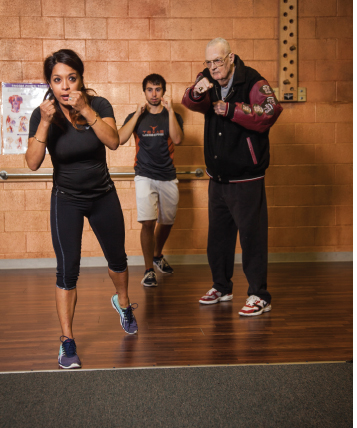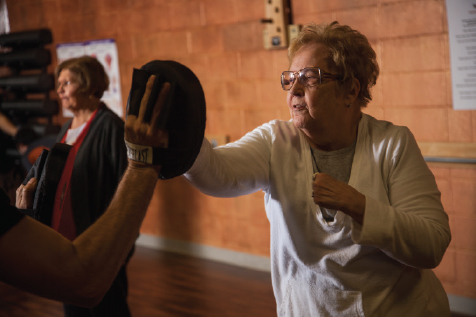The Fit Four and Mr. Fred

It’s 9:30 a.m. Another weekday morning at Spirit Fitness Training in North Austin as a close-knit group of four gathers to work out together on the studio floor. They start their warm-up routine, manipulating exercise balls, agility ladders, ViPR cylinders, step boxes and more—taking their place alongside young athletes and urban warriors. The entire gym holds a hushed level of respect for them. They are one of the most driven and committed training groups that take the floor here. Their names are short—Ms. Ann, Ms. Sarah, Ms. Sue, and newbie, Mr. Fred—but their bodies are strong. And their ages, ranging from 74 to 82 years old, are just a number.
If you want concrete evidence that regular exercise can change your life, come by and join this group of seniors for a workout. They’re always up for a challenge. At 82 years old, the group’s most senior and tenured member will tell you, “The body learns.” You will hear her repeating that to her workout group and to herself when faced with balance disks, beams, and stability challenges. And she is right. The body does learn.
Each of these individuals have faced and continue to face unique physical and medical challenges: Type 1 diabetes, cancer, stroke, chronic obstructive pulmonary disease (COPD), asthma, arthritis, sensory loss, broken bones due to falls—and those are just the physical challenges. Some are caregivers to their own aging parents and still parents to their own grown children. In days long gone, these four were accomplished business professionals, political activists, and professors. They are amazing individuals with rich histories and experiences who remain just as spirited and alive today as they were then. All of their stories are inspiring, but our most recent inspiration comes from our newest member, Mr. Fred.
Mr. Fred first entered the studio with his wife Sarah in the summer of 2014. The couple had recently relocated to Austin from Kentucky to be near family. Sarah had experienced some bad falls, and Fred had suffered strokes and cardiac complications. (He is diagnosed with dementia, has acute hearing loss, and restricted mobility.)
 Ms. Ann, Sarah’s older sister, was the one who began bringing Sarah to the workouts. Fred decided to tag along. For months, he would trail in to the studio, shuffling his feet, body frame bent over, mumbling to himself—his voice barely above a whisper. He didn’t talk to anyone. One look around and he would shuffle back out to the car to wait for the girls to finish exercising. His frailty kept all our trainers on active watch. One of us usually came up with an excuse for why we happened to be escorting him to his car.
Ms. Ann, Sarah’s older sister, was the one who began bringing Sarah to the workouts. Fred decided to tag along. For months, he would trail in to the studio, shuffling his feet, body frame bent over, mumbling to himself—his voice barely above a whisper. He didn’t talk to anyone. One look around and he would shuffle back out to the car to wait for the girls to finish exercising. His frailty kept all our trainers on active watch. One of us usually came up with an excuse for why we happened to be escorting him to his car.
One day—and this sounds crazy, but it’s true—Fred arrived with a copy of a magazine article I had written about the benefits of exercise in stress management. He held the magazine out to me and said, “I want to start exercising.”
It has been two months since that day, and Fred is now a transformed man. We noticed small changes in the beginning. He was unsteady but, with attention and practice, his shuffle was replaced with a confident walk. His body frame has started to respond in kind, and the slumped posture has receded, bringing Fred up to his full height of 6 feet 3 inches. When he began, it was a good day if we could keep him engaged for 10 minutes before he was too physically taxed to continue. But, in just a few short weeks, he completed the full 30-minute session. Fred now performs walking drills with agility ladders and cones and has developed enough awareness to work with exercise step benches—repeating patterns stepping up and stepping down—and has mastered resistance bands and medicine balls. We’ve discovered he likes sand bells, as well as shadow boxing with our MMA instructor and UT student intern, Bill Watts. He is just starting out on balance disks and while he is still wary of the air-filled pillows, his progress is noticeable.
I’ve watched in amazement as this man has literally changed before my eyes. He has reclaimed his vitality through movement and exercise and his wife, sister-in-law, workout group, and fitness trainers all agree: we are fascinated with his rebirth.
Most amazingly is that Mr. Fred’s voice has returned. He collects really cool leather jackets embellished with all sorts of badges and emblems and all our trainers openly covet them. After workouts, Fred now takes time to tell the stories of how he found them, and what they all mean.
He makes confident eye contact with me as we train. He asks questions, makes jokes, and smiles. He connects with the world around him and he remembers. Despite being diagnosed with advanced dementia, he remembers. Sarah and Ann will tell you that Fred’s mind is most engaged when he is at the gym. At home, he still cannot operate the telephone or remote control for the television.
No workout is ever the same, but the goals for every workout are rooted in reinforcing the body’s basic movements: Pushing, pulling, bending, and reaching in all planes of motion, and in all sorts of pattern combinations. In movement, the body and mind are invigorated. 
Aging populations tend to avoid movement patterns that are no longer comfortable, and daily life can become an obstacle course. Decreased movement leads to decreased ability to function independently in the world. And loss of independence can lead to feelings of isolation, worthlessness, defeat, depression, and a general lack of engagement and connection with others. To maintain a good quality of life, self-esteem, confidence, and self-efficacy, we must continue to train the body to meet the demands of movement. Exercises need not be overly taxing, but they should support the aging body by mimicking and reinforcing daily life activities.
Despite Fred’s physical and mental challenges, his body continues to learn and he remains vital. For him, as well as the other three women who workout with him, exercise is medicine.
Physical activity, exercise and aging
The benefits of exercise are numerous and well documented. Maintaining moderate physical activity improves health, independence, and quality of life as we age—even when we are battling disease and disability. Being physically active means getting up and moving—walking the dog, working in the garden, cooking, housekeeping, and grocery shopping. Exercise is planned and structured physical activity, such as a regular walking regimen or fitness class for which we consciously make time. The more physically active you are, the more likely you are to exercise. And the more you exercise, the more likely you are to remain physically active.
Myth: Exercise can be risky
Aging populations may be reluctant to exercising out of fear that they may get injured.
Fact: Inactivity is the real risk. Lack of physical activity leads to heart disease and metabolic disorders—meaning more trips to doctor’s offices, more medications, and more hospitalizations.
Myth: Older adults cannot manage life on their own.
The body is like any other machine; it gets rusty with lack of care and use. When older adults lose the ability to do things on their own, it’s not because they’re getting older. Instead, it’s usually because they are not active.
Fact: Inactivity ages the body.
Myth: You can’t teach an old dog new tricks
Yes, you can. Doing some form of physical activity is better than no activity at all.
Fact: Exercise helps manage stress and improves your mood. Studies also show that exercise can improve cognitive function. Regular physical activity stimulates blood flow to the brain and reinforces our ability to manage tasks, recall information, and connect with the world around us.






